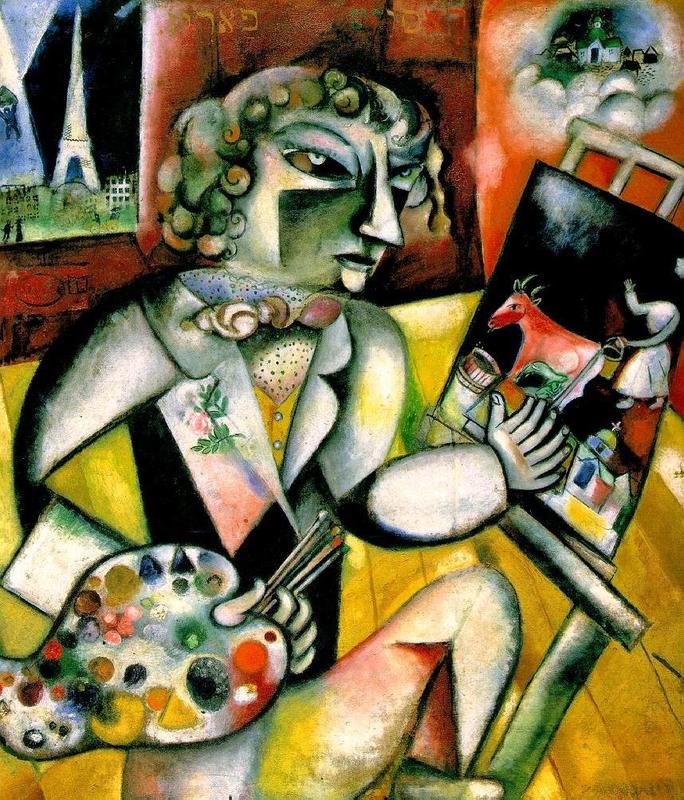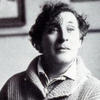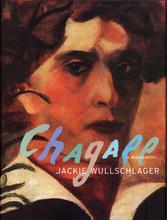More about Self-Portrait with Seven Fingers
- All
- Info
- Shop

Contributor
Both influencing and influenced by the cubists, Moishe/Marc Chagall painted L'Autoportrait aux Sept Doigts (Self-portrait with 7 Fingers) as a way of affirming his Yiddishkeit, his being a Belarusian Jew, without separating himself from the exclusive art scene in Paris.
His affirmation was, as political affirmations usually are, folded into an idiom and a language that is rare in the "art-world": the Yiddish phrase, "Mit alle zibn finger," to do something with seven fingers, means "to do it as well as one possibly can." This was less a choice than a duty for Chagall, who understood that the first, and perhaps greatest, obstacle to his success was the very same thing that made him excel.
Raised in the Hasidic movement, noteworthy for its tendency to go beyond the requirements of the laws of the Torah as observed by most Jews, Chagall could easily have seen visual art as idolatry, and renounced or avoided it. "Judaism struggled with ancient idolatry," he writes. "We left nothing behind us in the world's museums except for Torah Scrolls and the abandoned synagogues…" Chagall's compromise in this regard was to bring the flavor and emotion of the shtetl, the Jewish ghetto, into the painting, unseparated from its roots in the Torah and the Middle East. Furthermore, Chagall's references to the Torah in his work were not flippant or halfhearted, but central.
L'Autoportrait represents Chagall's brilliance in not only switching between the codes of Yiddishkeit and Parisian art, but developing a layer of pnimiyus ha-Torah, an inner or Kabbalistic reading of the Torah, concealed from view within a work of "modern art." "Even if...[Chagall's] graphics is just a philosophy of his art, it is cognate to that fiery philosophy with which the Kabbala seared the thought and heart of Judaism." Whereas most Christians, Jews, Muslims and Bahá'ís read only the nigleh ha-Torah, the plain, external meaning of the text, there is always a second, inner strata of the text, whose commentaries date back to the times of the Beis haMikdash, the Temple. The same is true of L'Autoportrait: on the surface, you see a man with a rare medical condition, seven fingers on his right hand, portrayed in a geometric, cubist way, painting an image of a red cow. Beneath the surface, in the pnimiyus of the painting, is the Yiddish phrase, and beneath that, millenia of writings and oral teachings on the number seven, the menorah, the seven gates of the body, the seventh day, shabbos, the ceremonial significance of the right hand, the red heifer, and so on. For those who are turned off by these things, it's just a funny and odd painting. In this way, Chagall takes the shtetl attitude of survivalist pragmatism and introduces it to the museum. As the great teacher, the Rabbeinu Bachaye, wrote, "night is part of the day" in Judaism: hardships can become strengths when filtered through the genuine love of oneself and one's people.
Sources
- Rabbeinu Bachaye (Bahya ibn Paquda), commentary on Bereishit 1:3. Sefaria, https://www.sefaria.org/Rabbeinu_Bahya%2C_Bereshit.1.3?lang=bi.
- Chagall, Marc. "Speech at the World Conference of the Yiddish Scientific Institute: 1935." In Marc Chagall on Art and Culture, edited by Benjamin Harshav, 56-60. Stanford: Stanford University Press, 2003.
- Efros, Abram. "Chagall: The Palette. Graphics." In Marc Chagall on Art and Culture, edited by Benjamin Harshav, 198-204. Stanford: Stanford University Press, 2003.
- Wullschlager, Jackie. Chagall. New York: Knopf Doubleday Publishing Group, 2008.
Featured Content
Here is what Wikipedia says about Self-Portrait with Seven Fingers
Self-Portrait with Seven Fingers is a 1913 oil painting by Belarusian-French painter Marc Chagall, painted in 1913 in France. This oil on canvas is a self-portrait in which the artist represents himself painting a reduced version of Of Russia, of Donkeys and Others, with seven fingers on one hand. It is kept as part of the Chagall collection at the Stedelijk Museum Amsterdam, in Amsterdam, Netherlands.
Check out the full Wikipedia article about Self-Portrait with Seven Fingers













